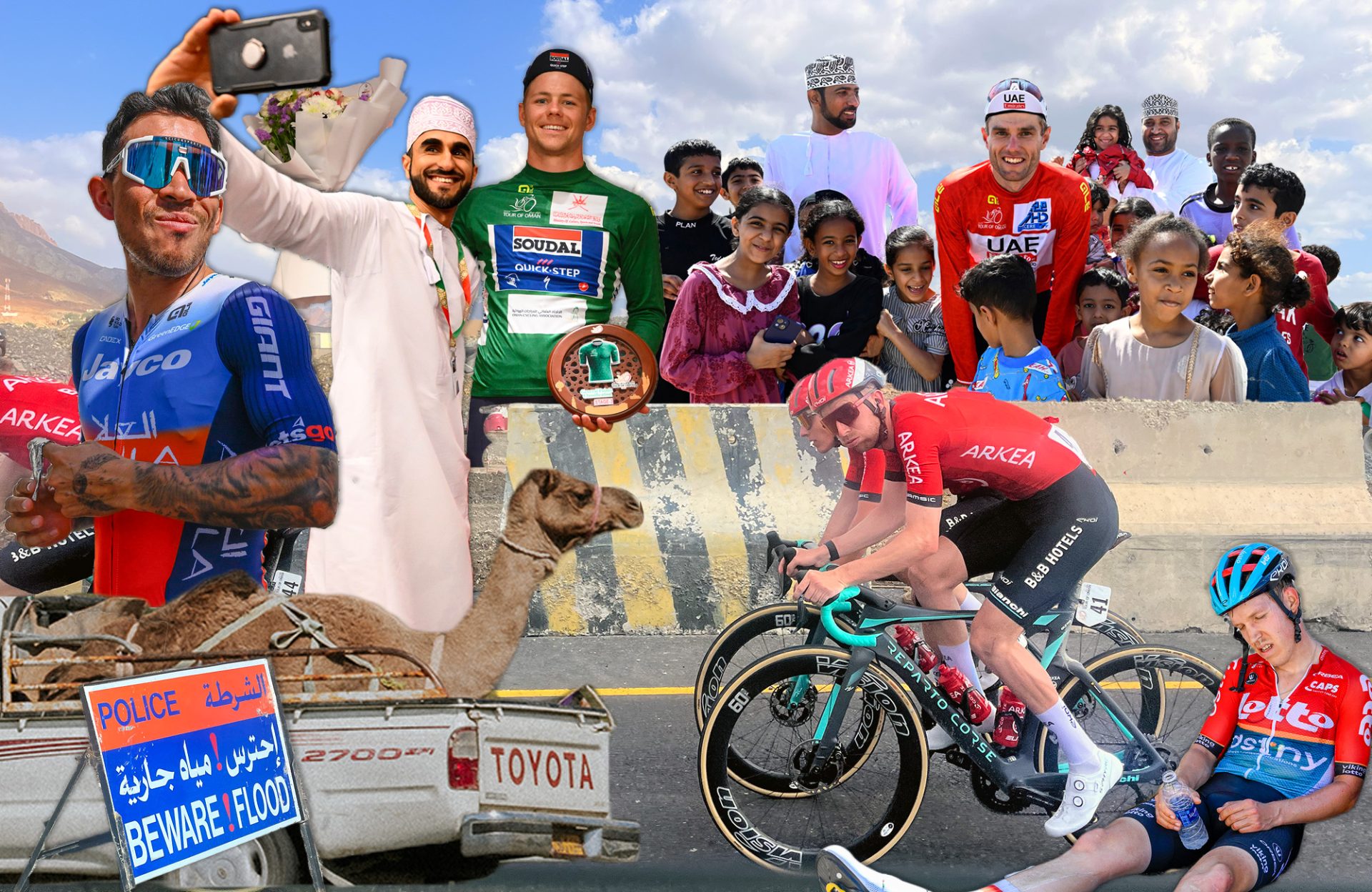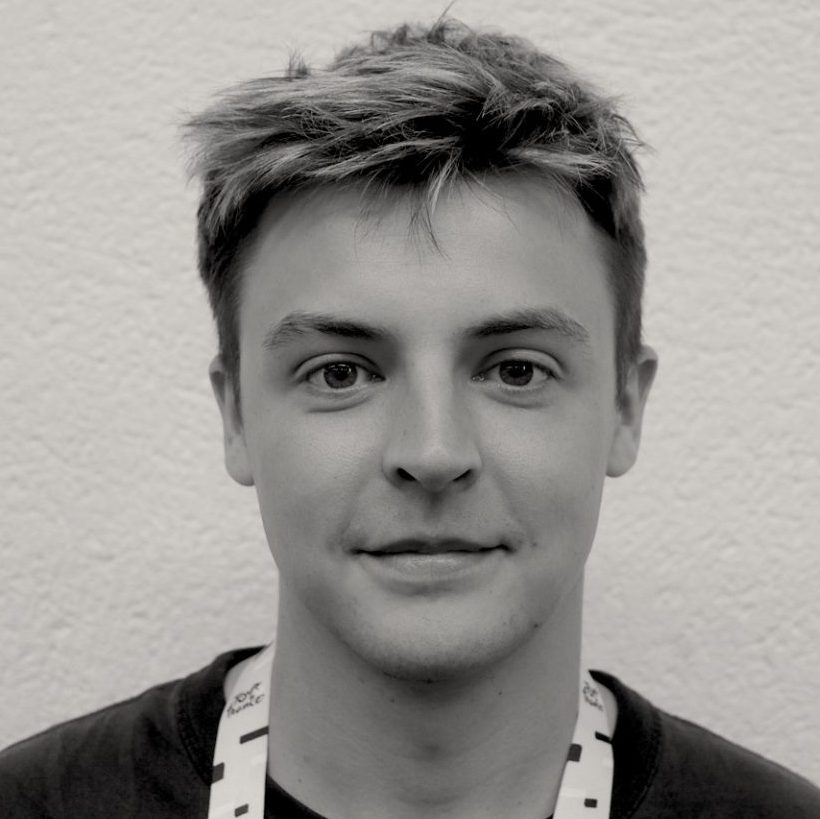I walk onto the plane and sitting in business class, just in front of my first row of coach, is UAE Team Emirates’ Vegard Stake Laengen. Coincidentally, he is the last rider I saw and spoke to in 2023 in Guangxi, and now here he is again, for another year of planes, hotels, and bike races in far-flung destinations.
These are the first moments of the press trip for the 2024 Tour of Oman. A race run by Tour de France organisers ASO, accruing a reasonable field of riders looking to build some early-season form, and international media invited along at the Sultan’s expense in order to generate some coverage of the event.
After a winter where I find it common to fall out of love with bike racing after months of over-saturation, a new country and culture in which to observe the madness of the cycling crowd is usually remedy to get the blood flowing for a new season.
Other colleagues across the industry have swanned off to the Tour Colombia, some got their fill in Australia. My flight ticket reads cost: €1,205.09. Carbon footprint: 1,164 kg of CO2. The Paris Agreement goal says each person should limit their use to two tons per year, and I’ve already used half of mine by February.
At the pre-race press conference, tucked away in a boardroom down a wing of the grand Hormuz hotel just behind the airport, the President of Oman Cycling Saif Al Rashaidi and ASO CEO Yann Le Moenner traded the usual pleasantries, promising brighter futures and stronger ties. This is the second return of the race since the COVID-19 pandemic. Oman wants to continue encouraging the few million tourists that enter every year, and ASO presumably want to keep bolstering their financial war chest and influence amid growing speculation that a One Cycling challenger will soon arrive onto the scene, promising to upend the established order of cycling, of which ASO sits at the top.
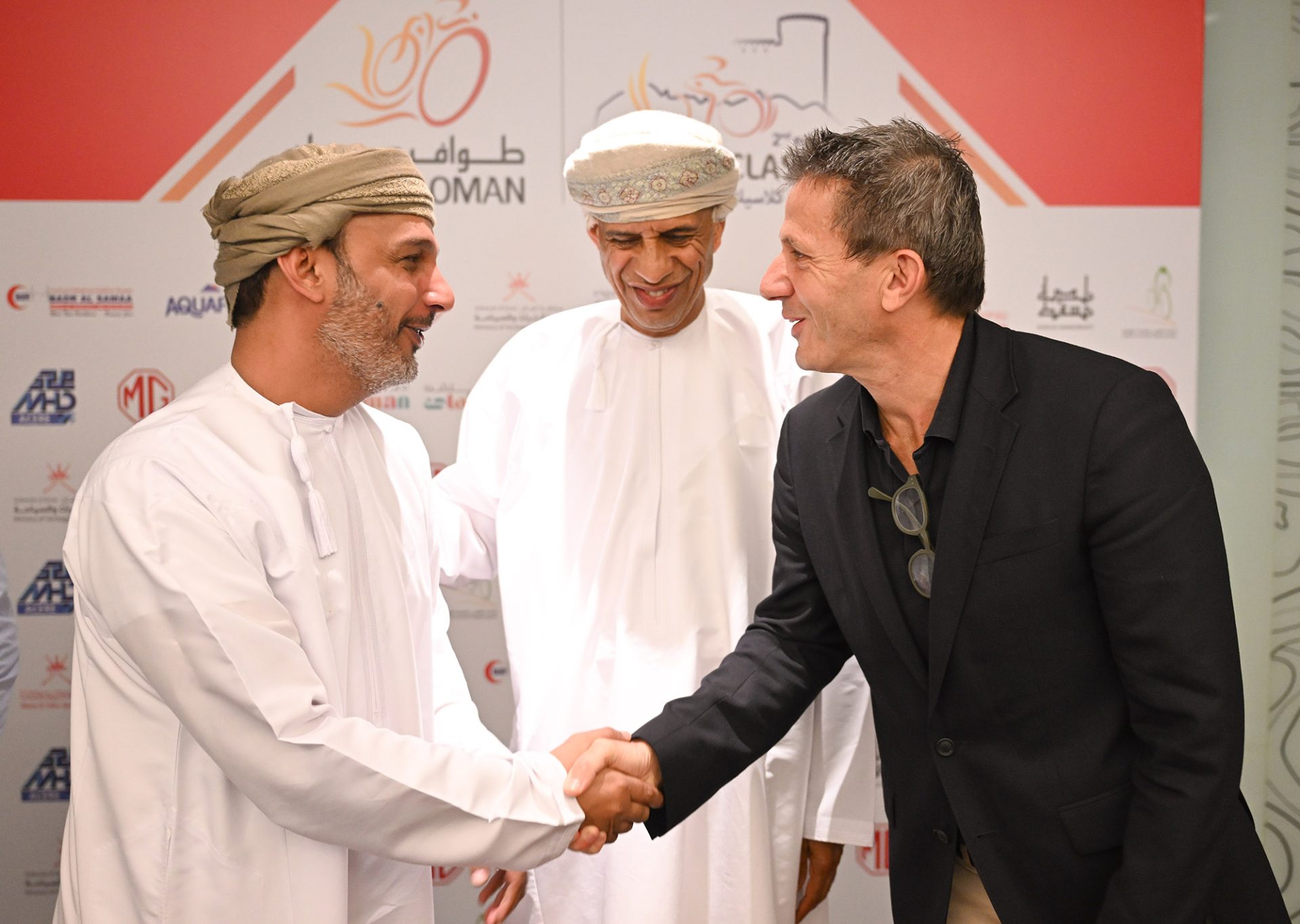
“How integral are these international races to ASO and how you see yourself progressing into the future. Is this something you’ll look to do more of and is Oman a key part of that?” we asked when the floor was opened to questions, hoping to glean some insight into ASO’s vision of their future.
“We do believe, we strongly believe as a matter of fact, that it’s part of the mission of the Tour de France to develop cycling everywhere in the world,” Le Moenner replied, before launching smoothly into the tidy origin myth of the Tour of Oman.
“The story started on the Tour de France, when at the time the Emir from Qatar was somewhere in the south of France and his car was blocked by the Tour de France. He got out of the car and said to his personal photographer, ‘what is this?’, and he replied ‘it’s the Tour de France, your highness’. And he said I want that in Qatar and that was the beginning of the process. Very quickly, when we entered into this relationship we got in touch with Oman, it was clearly one of the greater cycling destinations.
“Then time after time, we are actually bringing the expertise of the Tour de France to help the sport to develop and every time it is not ASO coming and doing everything, it’s a close collaboration with the national federation. We are also developing experience with the Saitama Criterium in Japan, and in Singapore. We are in the Arctic Race of Norway, we are in many territories. We do believe cycling is growing all over the world and if we can help this is a great thing. We are highly motivated and committed.”
The selected star riders (who surely must feel good that their current stock is high enough to denote them worthy of this extra chore, despite the inconvenience, right?) then proceed outside to huddle beside the ornate swimming pool that you’re not actually allowed to swim in (that one is hidden behind). They answer questions of the past and the future, these two intangible things few of us barely have a grip on.
There are a number of sprinters here – Alexander Kristoff, Caleb Ewan, the upstart Paul Magnier, Fabio Jakobsen – despite really only having two out of the six days reserved for their chances, but some had already taken a punt on the race before the route was released two weeks ago, and so they’d already made their bed. This select group clamber up above the pool, arms wrapped around each other for a photograph. They are then released back to their hotel rooms to once again while away the hours in a bed that isn’t their own.

At dinner, I am for some reason not allowed into the main restaurant, and instead directed to where the teams are eating, or have eaten already. I slink onto an emptied Astana Qazaqstan table, a few solo riders still chewing their way through chicken and rice. The next day I am again denied entry, but two days of rider food is enough for me and I desperately, and successfully, make my case to be allowed back into the real world of eating.
The Muscat Classic now precedes the opening stage. A one-day race introduced to provide extra UCI points and further reason for teams to accept their invitations to the race. We snooze in the bus in the hills above Muscat, looking down at the sea and the sprawl; it’s hot and everyone is adjusting to the heat and the time zone after overnight flights got us into the country at the crack of dawn.
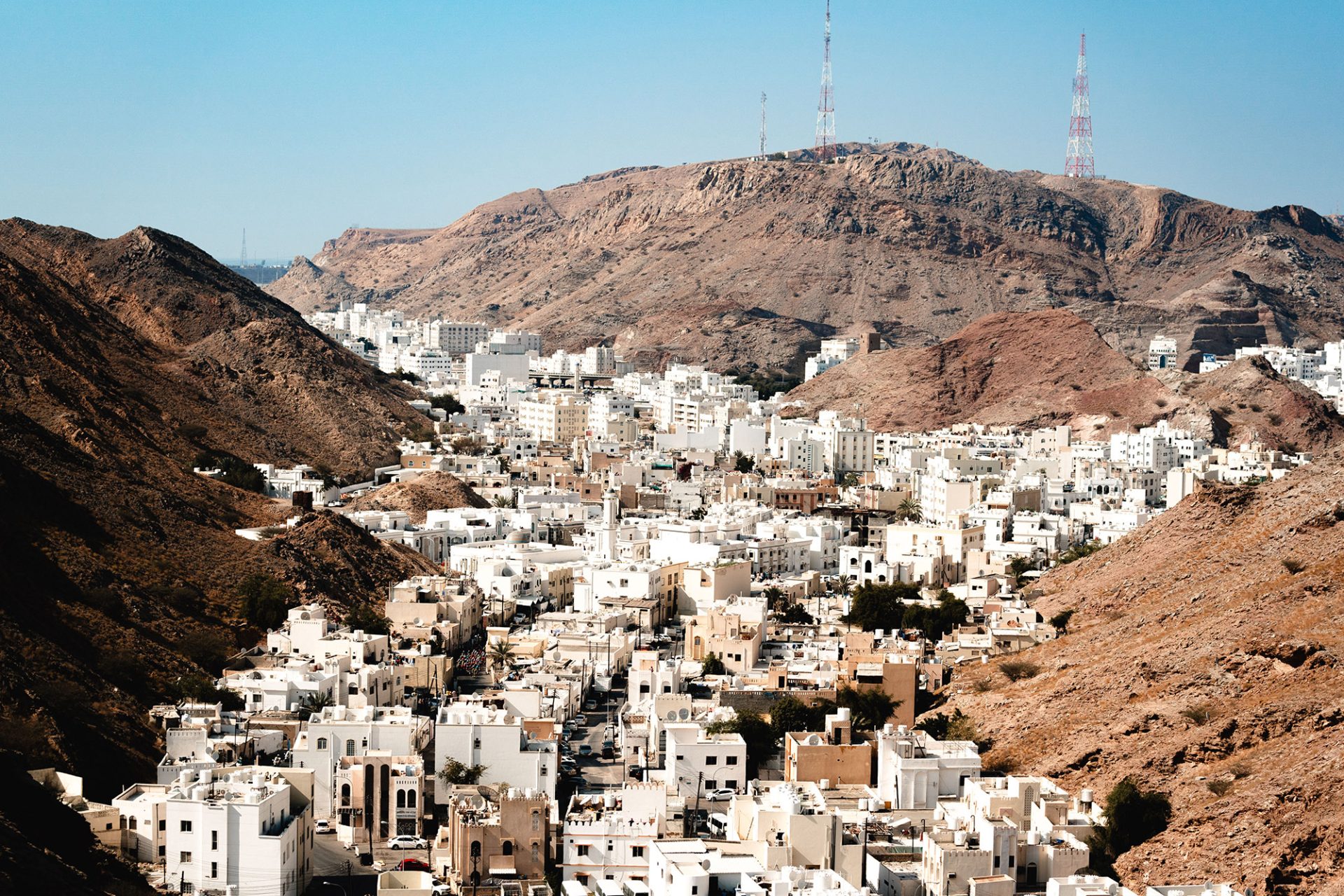
We wander down to the finish, a sweeping drag up from a final climb, where UAE Team Emirates’ Finn Fisher-Black had launched his attack. With a vantage point of much of the last kilometre, you could watch the individual speck of Fisher-Black thrashing the pedals in his attempt to keep the surging bunch and its sprinters at bay. With 200 metres to go, the Kiwi realised he’d done it, taking the time to lift his arms aloft and get his team’s week off to the best possible start.

The sprinters, thwarted, will be hoping tomorrow ends as scripted, otherwise it could prove to be a very long week in the desert.
Sprung monoliths soundtracked by a comeback roar
Stage 1: Oman Across Ages Museum -> Oman Convention and Exhibition Centre (181.5km)

We drive an hour and a half out to the Oman Across Ages Museum, opened less than a year ago, and a stunning modern architectural achievement light years ahead of a city and country that at least in appearance is beholden to tradition – not that that’s a bad thing.
A young man is ready to give us the full tour but is informed he only has 20 minutes and so we begin hurtling past easel stands containing photographs of nature, fake graves showing us skeletons of ancient human and animal ancestors, and a potted history of the various eras, conquerings and liberations of this stretch of the Arabian peninsula. The museum opens with a Range Rover once owned by the Royal Family, and it too closes with a collection of other models of royal conveyance. As we progress into the modern day we are told how the Oman oil exports are currently funding education and healthcare for all citizens, and how equal men and women are these days. It forgets to mention that homosexuality is still illegal, but hey ho! On with the tour!

Outside, next to the sign-on, a group of men perform Al-Ayyala, a traditional dance of northern Oman featuring the chanting of poetry and the banging of drums, which is used for national celebrations, weddings and, it turns out, bike races. Swords are held aloft and rattled so that the blades wiggle. It’s one of the few cultural touchpoints we feel all week, one that punctures the familiar formality of sign-on as some riders stop to watch as they wait, bobbing their heads along to the beat.

The riders set off to little fanfare given our remoteness. We hop in the press bus for a 90-minute transfer back to the finish line in Muscat. There’s not much to look at on the way back that we didn’t already see on the way out. Houses seem organised into plots, and planning laws give those with a creative impulse full reign to design their house in any which way they want. Strip malls are dotted throughout. Barbers, metalworks, pet shops sandwiched in between meat shops.
The heat and thrum of the old bus soon has me nodding off, although I’m awakened numerous times by our bus driver, who must have mistakenly thought he was in the race too. Eventually, I am properly sprung from slumber by an almighty crash as a cool box tumbles over that belonged to someone I didn’t recognise who had hitched a ride and plonked his possessions on the back seat next to me before heading back towards the front. Melted ice pours out, flooding the seat and me. As the lid of the box becomes visible, I discover the identity of the box and its owner. Cofidis.
The man, I presume a soigneur, drifts back to see what’s happened. He looks at me, and simply tells me in French that I should probably change seats. Fucking Cofidis, man.
We arrive at the finish, another long drag that this time leads up to the exhibition centre, the steps leading up to it interspersed with precisely coiffured plant boxes; all around the low hedgerows have sprinklers just poking out of the ground, keeping it all alive against the odds. The exhibition centre isn’t open, so I wander back down and duck into one of the big brand hotels that adorns the strip to wait for the finish. A bright pink neon sign hangs on the wall, reading: “Brunch is always the answer, the question is irrelevant.” Maybe waiting outside getting burnt by the sun isn’t such a bad option after all.
We head back out into the heat in time to watch Caleb Ewan outsprint his rivals and win what is supposed to be the only sprint stage of the race. He roars across the line, evidence that this race does mean something, in so much that if you are on a start line and a sprinter with a point to prove then nearly every contest will be important.
“I said to one of my teammates I hope I win today because having the weight off my shoulders on the climbs will make it a lot easier,” Ewan recounted, the relief of victory washing over him. “I think when you ride around with a bit more confidence and that pressure off it’s going to make it a lot easier. Now the rest of the race I can focus on going quite deep in the rest of the stages and building my form from here.”
Ewan, always honest, speaks of his relief. He is easy to like. Straightforward, doesn’t seem to have much ego, and it’s easy to tell when he’s not in a good mood so as not to approach him. Having won the stage and now needing to sit and wait for the podium, a seat vacated by Astana’s Gleb Syritsa opens up a gap for a line of fans to sit down and take their photo with Ewan, who has no choice but to sit and smile through it, willing the podium ceremony to start sooner rather than later.
The heavens open
Stage 2: Al Sifah -> Qurayyat (170.4km)
A different view for stage 2, out of the grasp of the chaotic bus driver. Today I’d be traveling in one of the press cars, which are allowed in the race, flitting between breakaway and peloton, giving us as close a vantage point as you can get.
Our driver for the day, entrusted to know how to navigate roads filled by a bike race, is Jean-Pierre Heynderickx. A former rider who won the final Madrid stage of the 1989 Vuelta and subsequently has been a sports director for nearly two decades (most recently with Bora-Hansgrohe for four years), he is taking a break after years of back-to-back Grand Tours to do a bit of driving for ASO and also work on his own cycle tourism business.
From first meet you can tell he is woven into the fabric of cycling, as Flemish as you can get, having been born in Gent; he knows most people at this race and stops to chat with them all. Cesare Benedetti laughs away, as other sports directors float past and call out a hello.
JP, as we’ll refer to him, drives at the correct infernal pace to safely navigate a bike race. As he accelerates through corners, classical music often plays from the speakers, soundtracking his wealth of stories from life inside cycling. One tale involves how despite living 25 km from his team’s Classics hotel in Roeselare, he spent the entire month for 10 years straight living with his team at that Hotel Mercure, in case a rider needed something in the night, and to feel connected to the team. Everyone in it together. Plus, JP says, if you’re going home every day you’re only returning to more work.
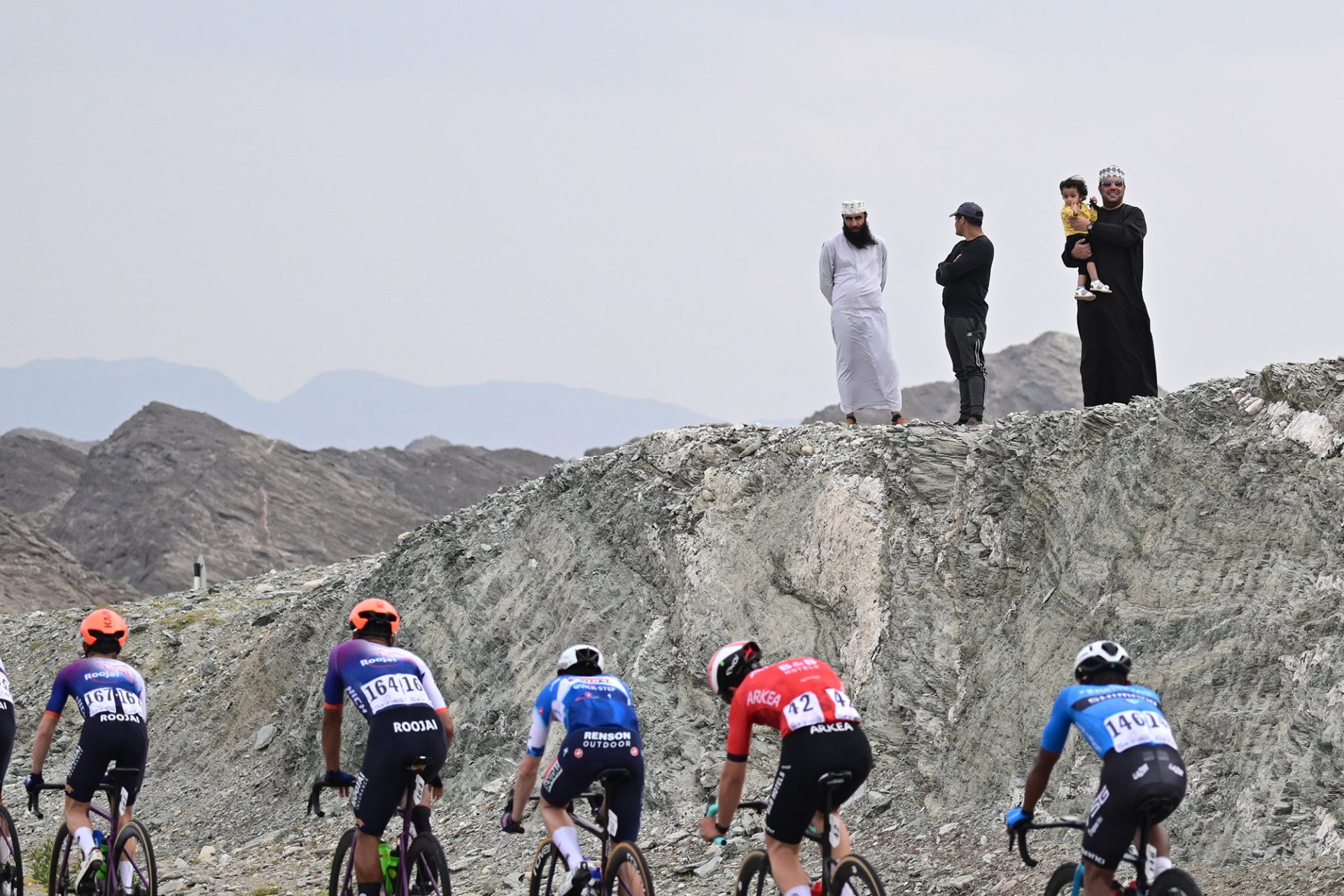
For the past two days, JP has had the French twins in his car. They are two of the youngest members of the press trip, and run their own Instagram that they’ve built up to 40,000 followers in just a couple of years, bringing you close to the action and the riders at any race they can get to. Their youthful exuberance has provided levity on a trip mostly occupied by cynical hacks, here for work rather than pleasure, but for Antoine and Grégoire, this is all still an adventure, enthralled with the eternal possibility of everything that the Tour of Oman could be. On the drive back to the hotel they tap away on their phones, cutting, sticking, perfecting their snippets of the race for their audience back home.
Amongst the escapades the twins got up to on the first two days of the trip was an attempt to borrow a local child’s bike and ride it behind the peloton, as well as try and buy some McDonalds and hand it to a rider mid-race. Luckily, JP was on hand to dissuade them from both of these ideas.
JP was clearly enamoured by them, but is likely glad for a slight break. I am accompanied by Niels, a Belgian journalist working for Wielerflits, and Thomas, who works for L’Équipe.
Over the top of the climb we reach a sharp corner. “There’s a crash every year here,” JP tells us, loose gravel on the apex and goats along the barrier combining to provide a peculiar concoction of danger. As we continue and look back, the fall is sheer and littered with car parts from crashes past. “Tyler Farrar crashed there once,” JP notes. “He spoke good Dutch.”
“And with a really good accent, too,” Niels adds.
In the breakaway, we look on as the Mongolian Tegsh-bayar Batsaikhan (Roojai Insurance) can do nothing but watch the attack from Óscar Pelegrí (Burgos BH) to nab the points at the top of the climb. The peloton follows a few minutes later, and so casual is their pace that when we hear them coming before they appear over the lip of the gradient, it is the noise of conversation rather than whirring of tires and chains.
We continue on the course, past the Sultan’s palace and his two yachts, which look more like cruise ships, and have 193 people working on them, apparently.

The police guarding the course are dressed in a purple camouflage that would only work as intended if they were operating at a Baltimore Ravens home game.
JP pulls over at a petrol station and an attendant starts filling up the car. Locals complain that the gas prices have become extortionate, yet it’s only around €0.60 a litre, nearly a third of the price back home in the UK.
We watch the race pass by alongside the boys working at the adjacent falafel stand who have come out to see what all the fuss is about. We return to the car just as the attendant seamlessly brings the tank to full and we are on our way again.
One of the ways that JP passes the time is pulling up next to team cars and chatting to the other sports directors he invariably knows.
“Are they on strike or something?” Bora-Hansgrohe’s sports director Bernie Eisel asks about the leisurely pace, before following up with his prediction for the stage. “They [meaning his riders] think Finn Fisher-Black first, Adam Yates second.”
Donkeys line the road, which combined with the landscape makes for a scene straight out of Waiting for Godot, which, really, in all of its futility, is apt for a bike race.
Up above, the weather is turning. Clouds are gathering. We pull over to watch the race pass next to a school. Students gather at the junction, also waiting for the race. “Ronaldo!” they shout, the Portuguese footballer is unbelievably popular here. “Messi!” shouts back JP, an exchange he gets Niels to film for him for a video to send around to his friends.

We’d seen rain on the forecast, but hadn’t expected it to fall today. A couple of drops come first, before the heavens open and water pours down upon the desert. We get going again, this bike race having turned from formulaic to world-first. Riding in the rain in the Middle East? JP can’t remember it happening before, and he’s been to most of these meets over the past decade or so.
Deep puddles clog the road, which are not used to absorbing water. Race radio clicks on in the car, the announcer explaining there’s been an incident, and you can hear riders yelling out in the background, although thankfully it seems to be a minor incident.
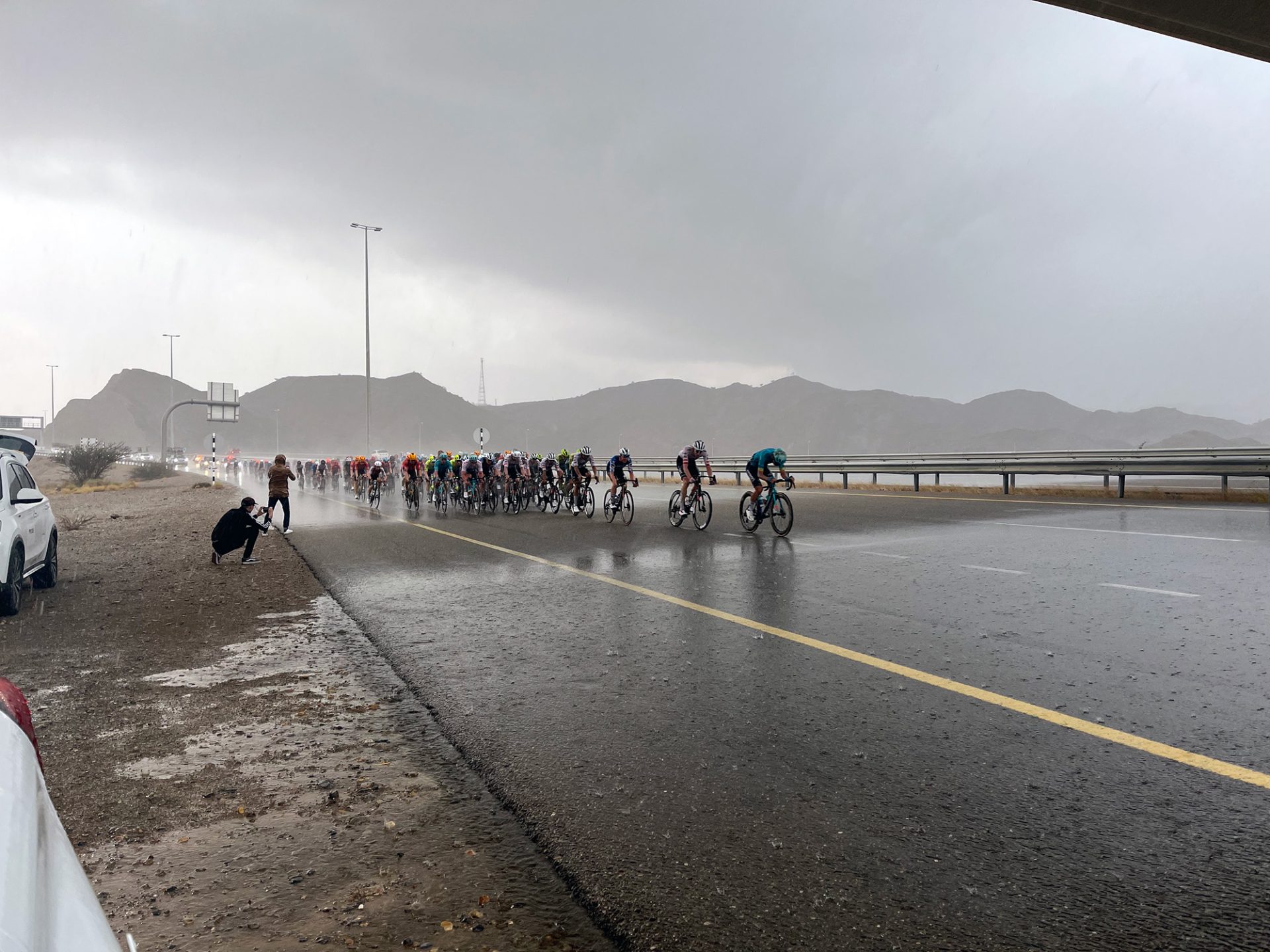
When the first drops had fallen, we asked each other in disbelief, “Was that rain?” and our incredulity only builds as the rainstorm worsens, falling like heavy pellets, the sort of rain where you are drenched almost instantaneously. There’s a flash of light, which we presume to be a speed camera or another car, but the rumble of thunder tells us that it was indeed lightning. Everyone turns to each other in the car, mouths open, eyes lighting up in excitement and maybe a tiny bit of fear. How much worse is it going to get? Rain isn’t supposed to fall in the desert. This felt like the unknown.
As for the riders, there was little excitement to be had. For our final stop the day to watch the race pass, JP pauses after he pulls over and reverses back under the bridge we’ve just passed, and when the peloton comes through it looks utterly miserable. Even as we drive up and over the bridge en route to the finish line, there is standing water.
On the drive up the climb the scenes are not what you’d expect from a bike race. Running water, bringing with it rocks, strewn across the road. We all take our phones out to video the state of the course. At the top, we park just after the finish line, JP spins the car around so we can watch the finale from the confines of our vehicle. Fisher-Black emerges out of the gloom and crosses the line first ahead of Soudal-Quick Step’s American Luke Lamperti. His teammate, Paul Magnier, stops soon after the finish line and looks confused. Our L’Équipe colleague asks him what the matter is and Magnier explains he lost his glasses with 500 metres to go. He goes back for them but reappears 10 minutes later, sans sunnies. A Kern Pharma rider follows with a bloody nose. A gaggle of Uno-X Mobility riders stop by our car, seemingly unperturbed by the inclement weather.
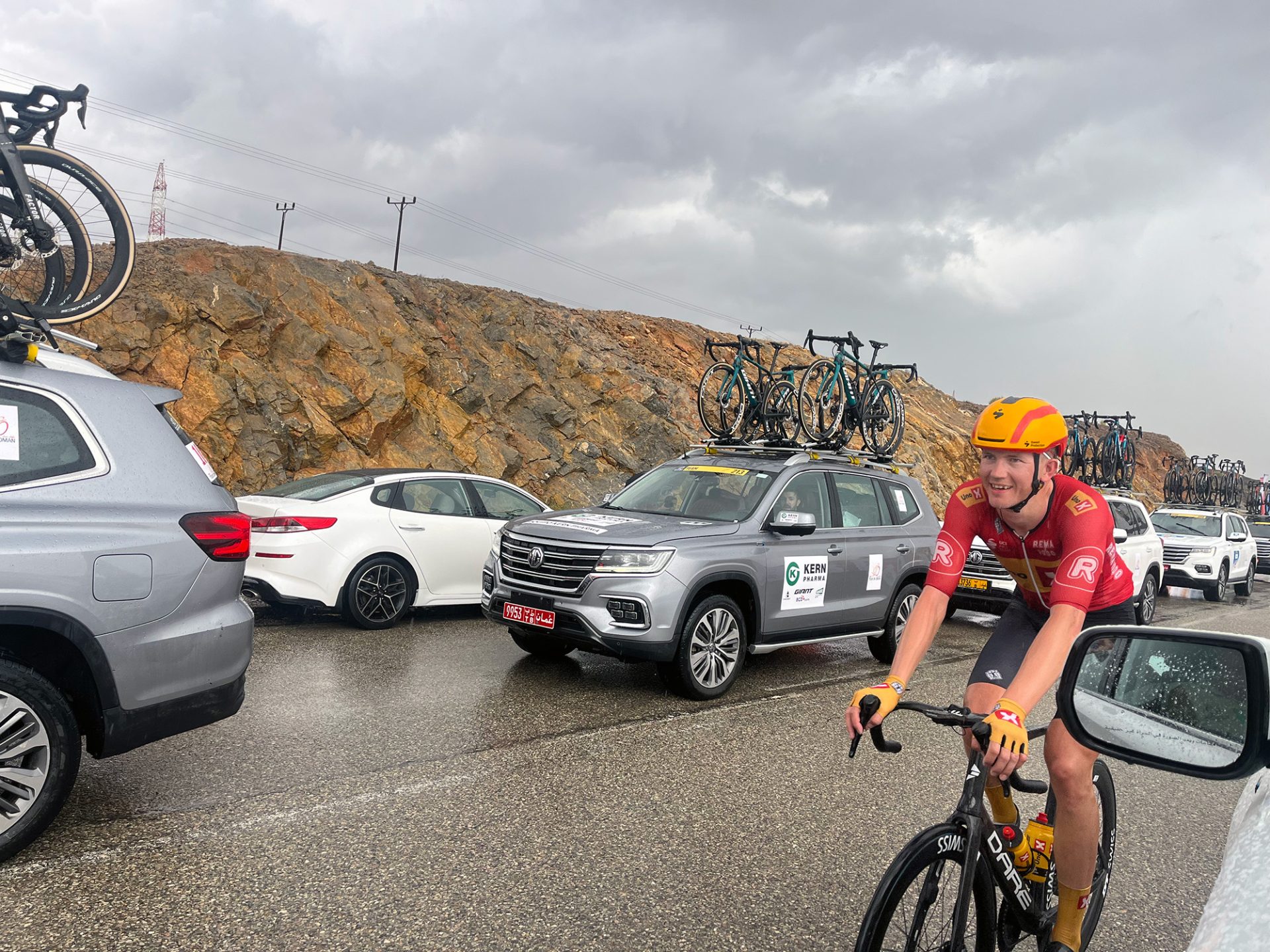
The twins run up to our car, absolutely soaked, buzzing at how good their video content today is going to be.
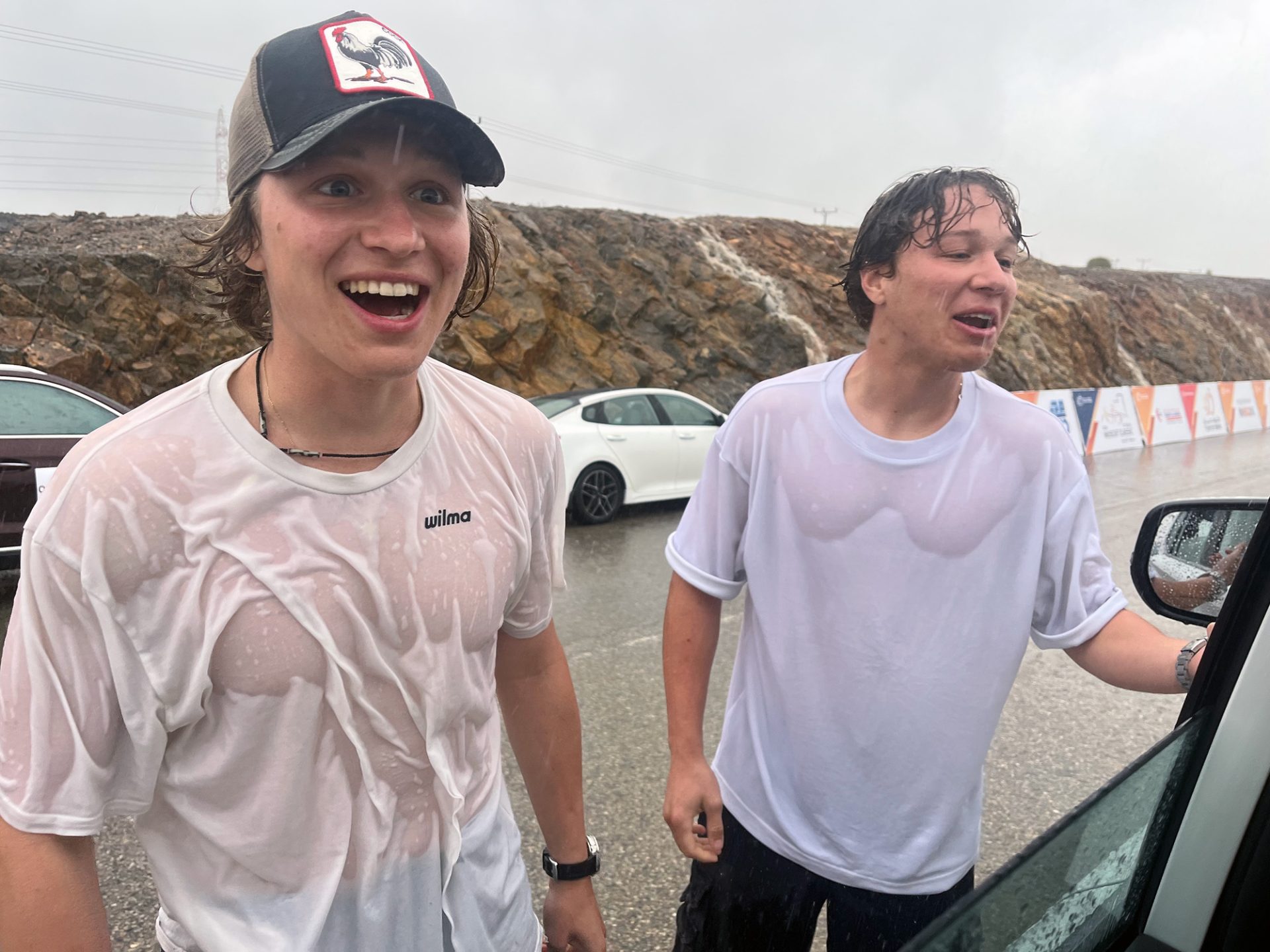
On the highway home a car appears heading the wrong way towards us, its driver not willing to go the long way around at the next intersection and instead creeping up the hard shoulder with his hazards on to pull in to his destination at the next turning. “This country is crazy,” comes the exclamation from the car.
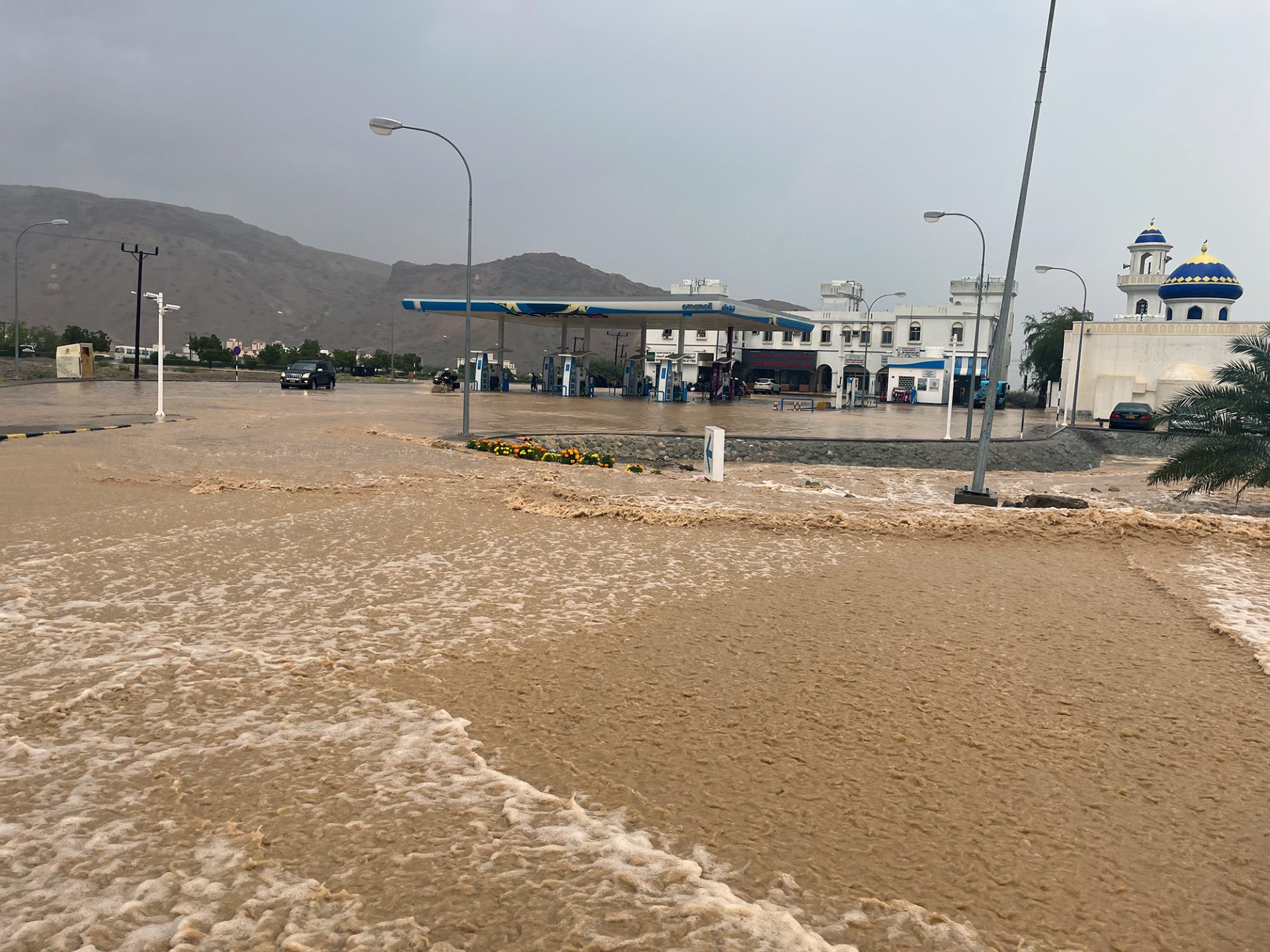
A woman in the front seat of another car as we enter rush hour traffic has her infant child on the front seat, holding his hand out of the window to show him what rain is.
L’Équipe’s Thomas, sat next to me, files his story. “Un final Dantesque” reads the description of the day in his headline. We pass a shopping centre, where at the entrance a man poses for a photo backdropped by the uncharacteristic cloudy mountains.
Have we seen anything like this before?
“Last year on Eastern Mountain the helicopter blew some fans away,” answers JP.
At the museum yesterday we learned how the old Omanis developed intricate gravity systems to transport water around the country, called aflaj. Today they would have just needed a big bucket.
Youth springs eternal
Stage 3: Naseem Park -> Al Bustan (76km)
For the sprinters who had almost felt tricked into coming to a stage race with one sprint day, the shortening of the route, taking out Eastern Mountain and therefore flattening the parcours considerably, would have been welcome news. The severity in the real world was that four people died.
ASO didn’t want to take any risks, zero headlines are better than any negative ones, and it was a decision the peloton seemed to agree with.
“In the Middle East for sure no,” DSM-Firmenich-PostNL sports director Matt Winston told us at the start of whether he’d seen anything like the scenes we saw on stage 2. “I remember in the Dubai Tour in 2016 the race was cancelled due to high winds, and that was also pretty epic. I think the only time I’ve ever seen rain like [yesterday] was Tirreno-Adriatico last year at the start of the TT when it cleared before the start.
“It was pretty good to see the race continue,” he continued of Oman. “I spoke with the ASO this morning and they deemed it safe and the fact there is not so much road furniture and roundabouts. The hilltop finish where the water is still running down … I think maybe if it was still one hour later then we maybe would have had to stop. Fair play to them today, they’ve changed the stage, they’ve fixed it overnight so we can still race and I think for me that’s the most important thing at this time of the year. We don’t want to come and not race a day, because you lose a total day of riding then. It’s not like you can go training and do good training so it’s important to keep racing. Fair play to the organisation for adapting, also the Omani authorities saying ‘Yeah fine, you can use our highway, 75 km of it,’ you’d never get that in Europe. So, really respect to ASO and Omani authorities.”

As the TV helicopter, which was actually a much larger, camo-decked military chopper sporting a broadcast camera, hovered overhead, the clouds still hung up above, which also left pools of water all around.
On the drive out we pass an IKEA. €8 for salmon and rice. What a deal. Western chains are everywhere. McDonalds, KFC, Baskin Robbins, even Wagamamas and Nandos.
Again, we find ourselves going past the Sultan’s palace as we retrace sections of the route from the Muscat Classic once more. Over the mountains, where we were supposed to venture, the flooding is still bad.
Rather than the likes of Ewan doubling up, or Fabio Jakobsen opening up his account for DSM Firmenich-PostNL, we instead get the spring buds of new talent bursting onto the scene, revelations for the future. Magnier was supposed to lead out Lamperti, but found himself so powerful as to open up a gap over the rest of the field that he sailed across the line with time to turn around and celebrate with the second-place Lamperti. Munther al Hsani from the Omani national team rolls in after the main peloton, exhausted from his hit out over the closing kilometres, rising up and down the overpasses for a good while, the gap on TV always looks better than it is, and he was duly caught.

We make our way back to the hotel, where the rearranged podium has been put. “We have time,” our ASO handler tells the crazed bus driver, in between his loud phone calls via bluetooth headset, urging him to slow down so we survive another journey with him at the wheel.
Back at the hotel, where staff periodically light frankincense that wafts through the lobby, a Bora-Hansgrohe rider goes up to an ASO staff member to tell him he lost his bike computer at the finish yesterday and asks if anyone possibly picked it up.
We order coffees while we wait. £5.86 for a cappuccino. The rain is still falling outside and a local takes a photo of the scene. “This is not normal?” I ask. “Usually, we only get three days of rain in a year,” he replies, smiling.
At the makeshift podium ceremony, Magnier makes way for the new race leader Lamperti, and hands over both his sunglasses and watch in order to get the photos that will please their sponsors.
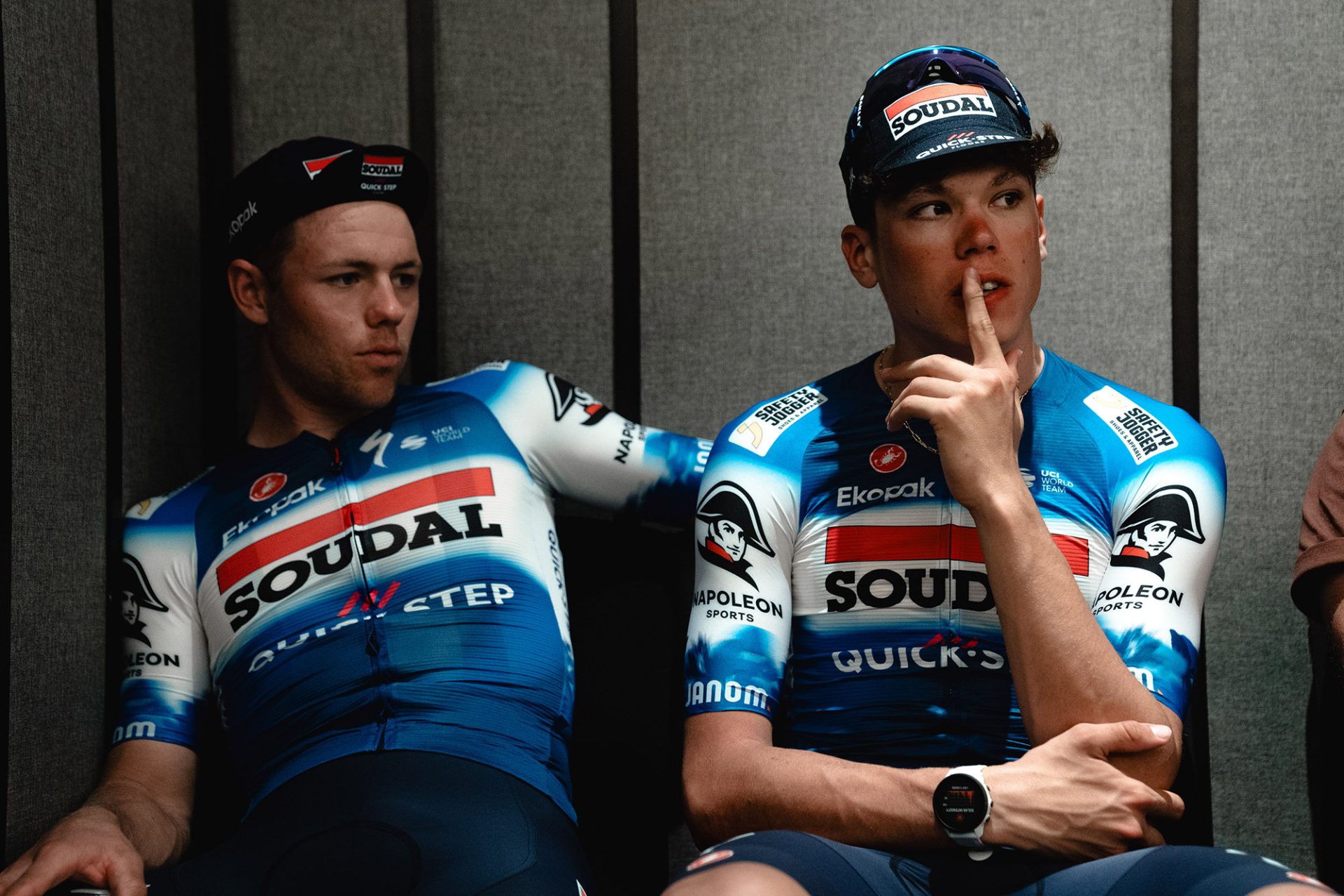
In a race that loomed for the sprinters as a training exercise rather than a chance to compete, the Soudal-Quick Step young guns have decided to not allow Fisher-Black all the fun, and use the shortened, altered stages to their advantage. The American Lamperti was watching the Super Bowl at breakfast, a few hours later he has a leader’s jersey in a reasonably-sized professional race. At these lower-key, early season meets, it’s a chance for the next ones up to grab their chance. Last year it was Matteo Jorgenson. Who knows where this edition’s winners will be in a year’s time. There can be a lethargy to these February races, that mostly thrive off the anticipation of bigger things to come. But sometimes, the young guns make you sit up and take notice.
Junior races without junior racers
Stage 4: Fanja -> Yitti Hills (104km)
Stage four also gets shortened, the roads are still drenched and so we get as close as we can to the mountains to offer up some climbing for the bunch.
The livestream isn’t on its usual OmanSportsTV YouTube channel, and the alternate providers are not discovered until later, leaving fans across the world in the live chat asking what’s going on. Back in JP’s car, we are amongst the few who got to see the majority of this bike race.


Today, my fellow passengers are a travel journalist from Madrid and a Liverpudlian reporter for a Scottish tabloid, who are on a more general press trip in Oman and have been brought to the bike race just for the day. The Brit lives in Glasgow, and his flat was on the recent World Champs course. He shows us photos of members of the Italian team staff, who asked to use his flat for the toilet and the wifi.
I chat with the Liverpudlian reporter about the state of British media, and he details his three-decade career as a journalist, which for many years meant working as a crime reporter, covering the goings on at the Liverpool and Amsterdam docks, and the drug trade and gang violence that populates both. When talking about gangsters who are now serving time, he says “potted” instead of jailed, which is excellent, especially in his Scouse accent.
The day is over almost as soon as it’s begun. This is a stage race limping on to the finish line. Everyone is gathered here, so we race, right?
Maybe the floods have scared away any potential crowds. Maybe I was expecting too much from a clearly closely-supervised and state-funded museum to help me understand true Omani culture. Instead, a search and sorting for top ranked of all time on the country’s subreddit shows a deep love for ‘Oman Chips’, which I finally get to try on the flight home and are worth the fuss. Maybe you disagree, but that is real culture, and it’s not going to be communicated to me at official press conferences. It could be the heat of living in the desert that means the streets aren’t teeming with people. Maybe socialising happens behind closed doors? Places often feel vacant. Maybe I was looking in the wrong places.
Amaury Capiot wins this next gallop to the line for the fast men, and Pelegrí plucks individual flowers from his podium bunch and hands it out to children as he goes. We’ve finished in a village today and so there are a few people here, wearing that familiar curiosity you see when a bike race lands on someone’s doorstep.

In the elevator down to dinner, a member of DSM Firmenich-PostNL staff carries two half-used bottles of Heinz ketchup in his hand. Something to break up the monotony of chicken and rice, and another day at a bike race the length of a junior meet but without the youthful exuberance.
The final flourish
Stage 5: Samail ‘Al Fayhaa Reshouse’ -> Jabal Al Akhdhar/Green Mountain (72km)
Finally, a proper finish at Green Mountain, although a middle section of the stage had been lopped out of the loop. The start is located at an old people’s home, where puddles still adorn the road, no gutters to be seen and the water not evaporating.
We are without the bus today as only 4x4s, or vehicles that look like 4x4s are allowed up to the mountain finish. A few years ago, a tourist bus, similar to ours, was descending the mountain and its brakes failed, crashing and killing everyone on board. As well as the security stop to disallow incapable vehicles from ascending, run-offs have been added for anyone whose car has been in the heat too long and pressed too hard on the brakes around the hairpin bends.
Instead, I jump in with Pierre, our ASO handler, who may be familiar to listeners of our Tour Daily podcast. He tells me this is his final day as an ASO employee, as he’s taken a job to be a press officer for Decathlon-Ag2r La Mondiale. He moves on and another young person will be drafted in, taking over Pierre’s work phone and identity, to keep the ASO machine rolling full steam ahead.
On the approach to Green Mountain, loose rocks cover the course. “Someone will have to clean that up,” says Pierre, who gets his phone out to voicenote the relevant colleague who can do something about this. We turn the corner and the next road is still flooded. In the end, they ended up re-routing the course.

A breeze gives us cooler air at the summit, where you only feel the heat of the sun when you sit still for too long. From the vantage point of the finish line, you can see the road wind up all the way to the summit, like how you can on the Col du Télégraphe before the Galibier in the Alps.
Adam Yates is the name everyone has been talking about all day. Naturally, he was deeply unstressed before the start, laughing with team staff as UAE continue to pump out the best music to be heard from any team tent.
Generators whirr away and pierce the silence. There is no phone signal, so all we can do is sit and wait, and actually watch a bike race in the flesh. It’s refreshing, to be cut off from everything but particularly at a race. It’s largely inconsequential in the grand scheme of things, of course, but now my mind is left to wonder of the potential outcomes that could play out. If I had signal, I could see who was in the front group, and from that deduce who was likely to go all the way. Now, I don’t know who may have crashed, or not have the legs today, or even attempted a valiant but failed solo move and is now getting passed by more cautious rivals.
Once again, the number of cars will signal the imminent arrival, then we will see the helicopter appear around the corner. When it does come, it’s always lower in the sky than you’d expect, and only able to be spotted because the sun glints off the windscreen deep down the valley.
You can just about spot one rider ahead of a thinned-out group, a slightly smaller silhouette than the accompanying motos.
As they progress, smaller and smaller groups peel off behind, discarded by the gradient. Intermarché-Wanty soigneurs ask ASO’s photographer to look through her zoom lens at who the rider in front is … it is Intermarché! They cant really believe it. “Louis?” they ponder. It is instead 21-year-old Huub Artz whose brave breakaway effort lasted until the final few hundred metres.
A bike change catches the eye due to the stoppage of a team car and the ant colony of felled rider, teammate, and staff hurry around to help.
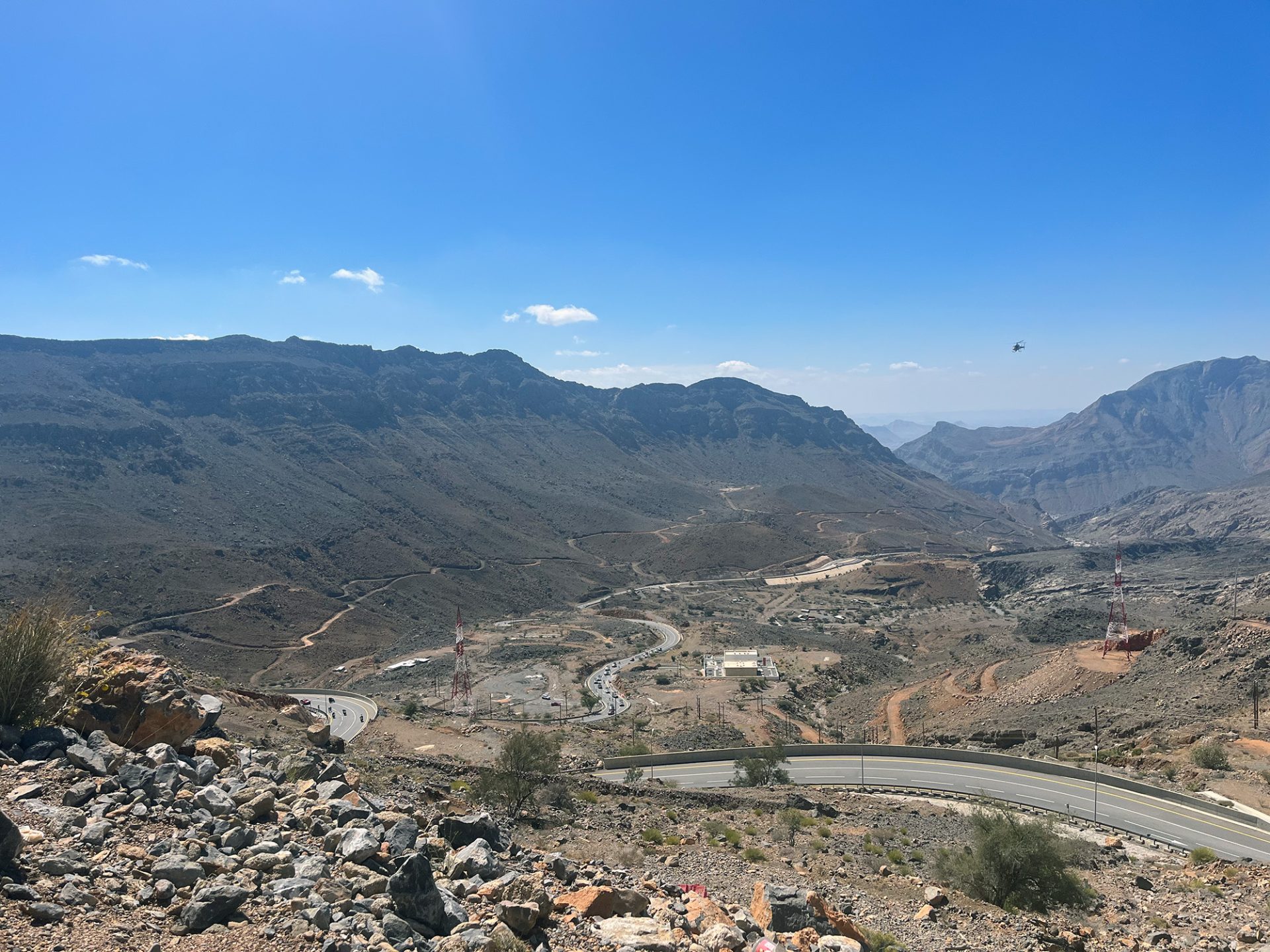
“Intermarché, OooAE and Quick Step, I think … I think Yates,” comes the live report from the French photographer. And sure enough, as we leave our vantage point to see the winner come up around the bend to the line, it is Yates, middlingly exerted, mutedly celebrating but making the right signals for the cameras that will document this. He is the winner of the stage and the bike race at large.
“We tried to make it work for Finn but he is a bigger guy,” Yates says later, so he had no choice but to latch on to Soudal-Quick Step’s Jan Hirt to make sure UAE left with victory.
Finn Fisher-Black and his red jersey slump against the barriers, having given it his all, as other riders come to a stop and need helpers to push them clear of the steady stream of others who arrive one-by-one.

There is mud on their clothes and glasses, evidence of the unexpected weather that has defined this race. Cesare Benedetti strips off and reveals a large Polish flag tattoo across his chest, the Italian’s adopted nationality from his wife.
In the closing ceremony, the Omani representative praises all parties for their co-operation in making sure we had a bike race at all, and stating that the goal now and into the future will be for this race to encourage tourism by showing off the landscape through the prism of bike racing.

Fisher-Black heads to the podium to collect his green jersey, and has to tell them to give him that green one when they try to present him with red, a slightly bitter pill.
The price of Yates’ victory, which will bolster him into his team’s home UAE Tour, is the un-ending scrum of media wanting a piece of him.
“Can you do the interview in the sun?” asks a TV camera operator, looking for the best shot.
“No, are you joking?!” Yates laughs.
***
Every morning Adam Yates has walked out of the hotel with his reusable coffee cup in hand, ready to be a bike racer. “To be honest I’m a simple bike rider, I don’t get involved in this stuff. I just train hard, work hard, turn up to whatever races are there on the calendar and try and win. I push pedals and hope for the best,” he said before the start of the race when asked about the One Cycling project currently being whispered about in various corners. He is doing what he can. Controlling his own controllables, as it were.
Should we all be more like Adam Yates? Not worry about the macro of our own situations and just complete the very specific tasks in front of us in search of a quiet and prosperous life? If you start to question why you’ve spent a week in the desert between beating sun and thunderous showers as part of a bike race paid for on someone else’s dime, that can’t be good for the mentals. Then you start to extrapolate further until you return under the rock from whence your biological ancestors once came.
Remain on task.
Adam, given the shortened stages, was there the risk any de-training could have occurred this week at what was supposed to be a warm-weather training meet?
“The level is so high in the sport it doesn’t matter if you race 150 or 50 kilometres,” he answers. “But I heard some riders trained more after the stages.”
On the drive home, we do indeed spot a couple of riders making the 90-minute journey by bike, team cars stationed behind them on the highway for safety. This leads to a couple of small groups of riders before we come across something much more spectacular. A peloton on the open road, bemused traffic passing in the three lanes to its left. A rare, pure moment of bike racing wonder and beauty.

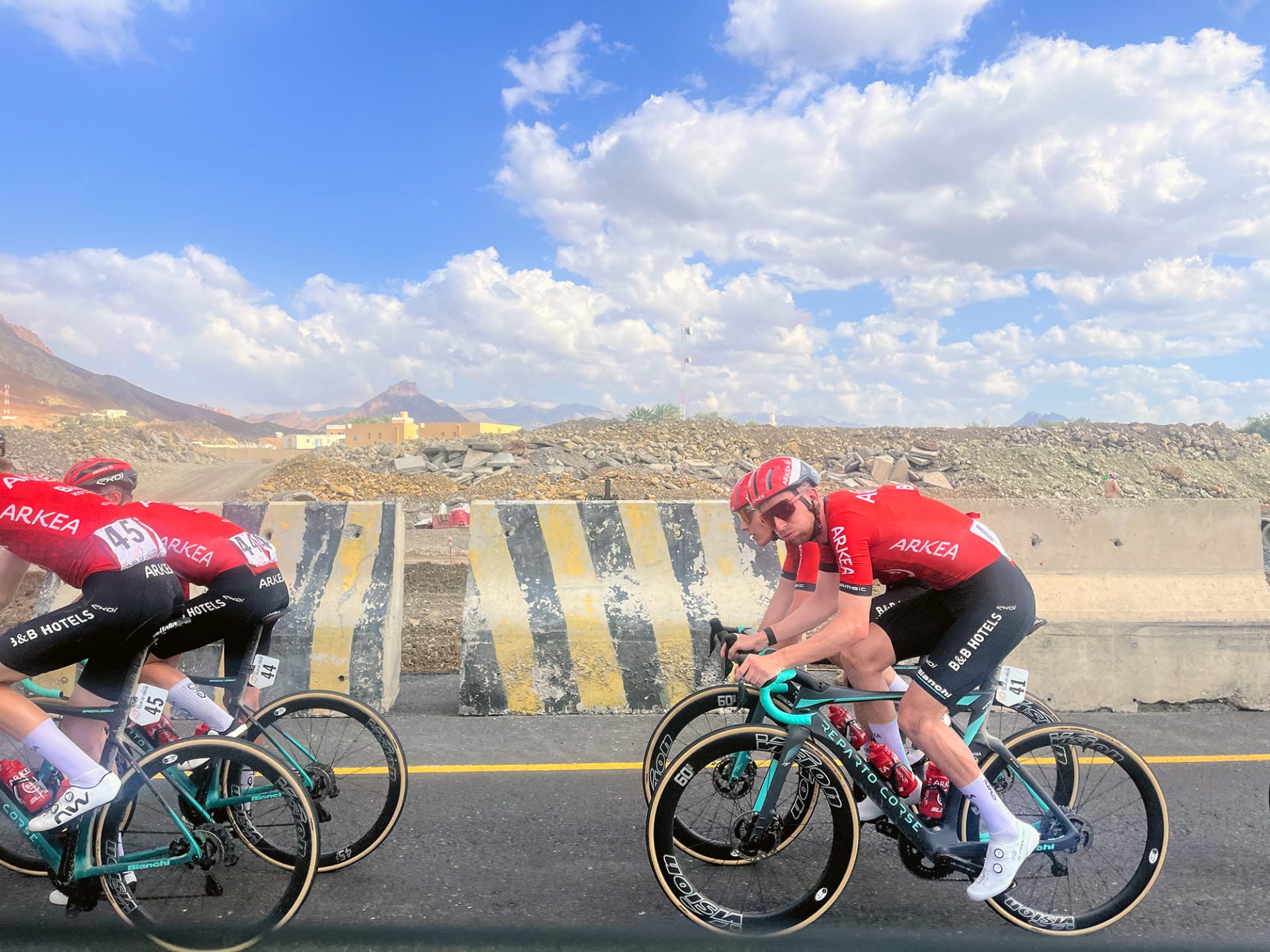
Back at the hotel for the final time, the French twins swap their own branded shirts with an ASO employee, buzzing at having acquired a beige polo shirt sporting the logo of the Tour of Oman as a memento. Fabio Jakobsen gets out of the lift on his way to the dining room, he passes Quick Step staff who wave at their former colleague. Riders spend all week passing each other while living in the same hotel, few interact or even acknowledge each other.
What to make of a race in the desert? One which lacks the beating heart and soul of something like the Rás, or the cultural exchange and otherworldliness of Guangxi. Money talks louder than the cultural connect ever will. A few days in a plush hotel surrounded by top bike racers as oil-dependent states look to diversify and grow their economies. The depressing fact is no-one would be here were it not for money. The talk is of growing Omani cycling, which is a noble pursuit, and shouldn’t be discarded. The appetite for that, however, remains a question. A venture out to the Old Market and beach in the city centre feels less busy with tourists than it did in 2019, according to journalists for whom this is their second or third trip to the Sultanate.
A bubble of peace within the chaos, a pocket of sanctity within arm’s reach of conflict. Life goes on as normal, but for how long?
I bid colleagues goodbye, agreeing we’ll see each other at Flanders. The ‘State of Palestine’ still shows up on the in-flight map. A husband and wife across the aisle from me sleep on each other’s shoulders, her finger marked from voting in the recent Pakistan election.
What did you think of this story?
